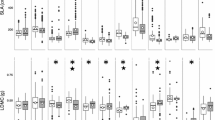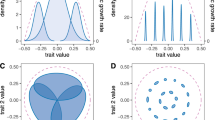Abstract
Plant growth form diversity (GFD) is high in the vegetation of North American deserts, and increases from north (Great Basin Desert) to south (Sonoran Desert). While abiotic features (annual temperature, precipitation, and seasonality) appear to limit the range of desert plant GFD, biotic features associated with the coexisting plants at a site, and their GF distribution, add further constraints. Climate may constrain the GF options at certain sites and select for some degree of GF convergence there, but within sites other species in the vegetation select for GF segregation that fosters the local coexistence of species. In this paper GF variation is viewed along structural niche axes, and related to classical niche theory; several corollaries of the theory are examined in the light of plant GF patterns. These are: a) regular spacing of species on the structural niche axis, and the concept of limiting similarity; b) niche axis complementarity, such that species dissimilar in position on one axis, e.g. GF, are similar in position on other axes, e.g. habitat or substrate, and vice versa; c) niche shifts in GF within species are expected, and occur, as the suite of coexisting species varies among sites with similar climate; d) in some desert plant guilds species with very similar GF do not coexist at a site, but act as geographical replacements in different sites.
Similar content being viewed by others
References
Agren, G. I. & Ingestad, T. 1987. Root:shoot ratio as a balance between nitrogen productivity and photosynthesis. Plant, Cell, & Environment 10: 579–586.
Barbour, M. & Minnich, R. A. 1990. The myth of chaparral convergence. Israel Journal of Botany 39: 453–463.
Barton, D. E. & David, F. N. 1956. Some notes on ordered random intervals. Journal of the Royal Statistics Society ser B 18: 79–94.
Brown, J. H. 1975. Geographical ecology of desert rodents. In: Ecology and Evolution of Communities (eds. M. L., Cody & J. M., Diamond), pp. 315–341. Belknap Press of Harvard Univ. Press, Cambridge, MA.
Case, T. J. 1979. Character displacement and coevolution in some Cnemidophorus lizards. Fortshritte der Zoologie 25: 235–282.
Cody, M. L. 1973. Character convergence. Annual Reviews of Ecology and Systematics 4: 189–211.
Cody, M. L. 1974. Competition and the Structure of Bird Communities. Monogr. Pop. Biol., Princeton Univ. Press, Princeton, N.J.
Cody, M. L. 1984. Branching patterns in columnar cacti. In: Being Alive on Land (eds. N. S., Margaris, M., Arianoutsou-Farragitaki & W. C., Oechel), pp. 201–236. Tasks for Vegetation Sciences v. 13. Dr W. Junk, Den Haag.
Cody, M. L. 1986a. Structural niches in plant communities. In: Community Ecology (eds. J. M., Diamond & T. J., Case), pp. 381–405. Harper & Row, N.Y.
Cody, M. L. 1986b. Diversity, rarity, and conservation in Mediterranean-climate regions. In: Conservation Biology (ed. M., Soulé), pp. 122–152. Sinauer Publ., Sunderland, MA.
Cody, M. L. 1986c. Spacing patterns in Mojave Desert plant communities: near-neighbor analyses. Journal of Arid Environments 11: 199–217.
Cody, M. L. 1986d. Spacing patterns in Mojave Desert plant communities. II. Plant size and distance relationships. Israel Journal of Botany 35: 109–120.
Cody, M. L. 1989a. Growth-form diversity and community structure in desert plants. Journal of Arid Environments 17: 199–209.
Cody, M. L. 1989b. Morphological variation in mulga. I. Variation and covariation within and among Acacia aneura populations. Israel Journal of Botany 38: 241–257.
Cody, M. L. 1991. Morphological variation in mulga. II. Covariation among morphology, phenology, and spatial patterns in Acacia-dominated vegetation. Israel Journal of Botany 40: 41–59.
Cody, M. L. & Mooney, H. A. 1978. Convergence versus nonconvergence in Mediterranean-climate ecosystems. Annual Reviews of Ecology and Systematics 9: 265–321.
Goldstein, G., Meinzer, F. & Monasterio, M. 1984. The role of capacitance in the water balance of Andean giant rosette species. Plant, Cell & Environment 7: 179–186.
Levin, D. A. 1978. The origin of isolating mechanisms in flowering plants. Evolutionary Biology 11: 185–317.
Levin, D. A. & Kerster, H. W. 1967. Natural selection for reproductive isolation. Evolution 21: 679–687.
May, R. M. 1975. Stability in ecosystems: some comments. In: Ecological Studies 39 (eds.) W. H.van, Dobben & R. H., Lowe-McConnell, pp. 161–168. Springer-Verlag, Berlin. 455 pp.
Pleasants, J. 1990. Null-model tests for competitive displacement: the fallacy of not focusing on the whole community. Ecology 71: 1078–1084.
Raunkiaer, C. 1934. The Life Forms of Plants and Plant Geography. Oxford University Press (Clarendon Press), Oxford.
Schimper, A. F. W. 1903. Plant Geography upon a Physiological Basis. Oxford Univ. Press (Clarendon Press), Oxford.
Waller, D. M. 1986. The dynamics of growth and form. In: Plant Ecology (ed. M. J., Crawley), pp. 291–320. Blackwell Scient. Publ., Oxford.
Author information
Authors and Affiliations
Rights and permissions
About this article
Cite this article
Cody, M.L. Niche theory and plant growth form. Vegetatio 97, 39–55 (1991). https://doi.org/10.1007/BF00033900
Accepted:
Issue Date:
DOI: https://doi.org/10.1007/BF00033900




